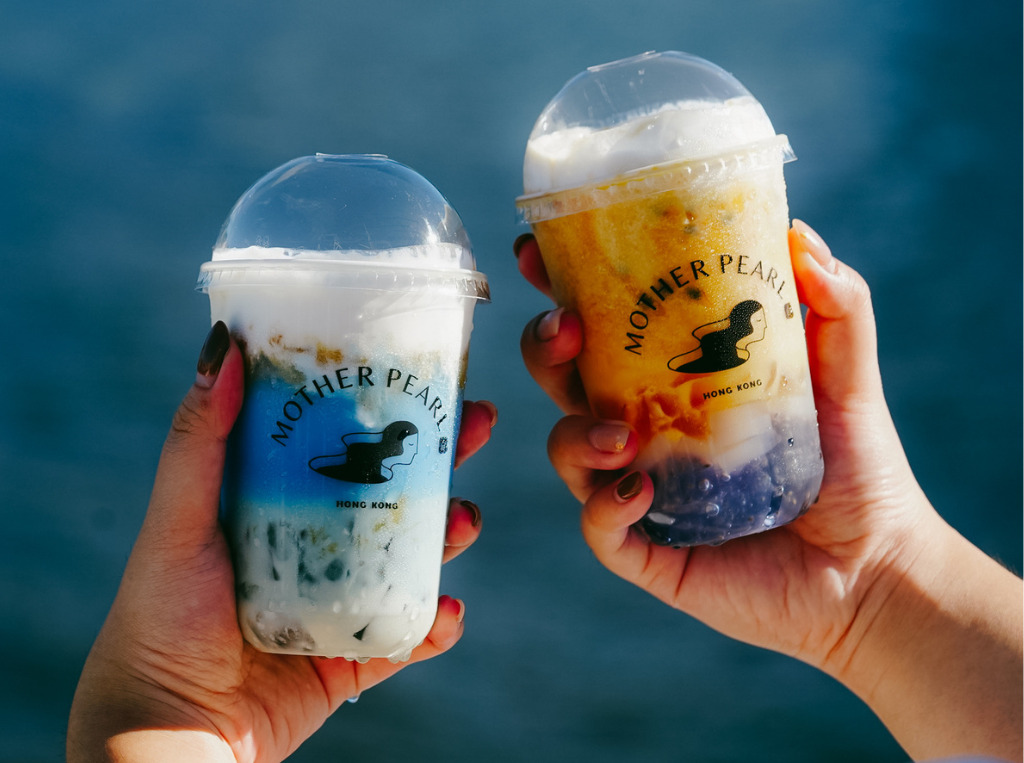‘It’s a Wellness Brand’: Mother Pearl’s Po Chen Spills the Tea on Hong Kong’s First Vegan Bubble Tea Chain
9 Mins Read
Mother Pearl, which opened in 2020 as Hong Kong’s first vegan bubble tea shop, is an outlier in the space. On the heels of opening its fifth location in the city this Monday, and ahead of launching the sixth store this weekend, its founder Po Chen bursts the bubble on the health aspects of her teas, why almost everything is made in-house, and her ultimate goal for the brand.
I’m not going to lie to you. I’m a bubble tea person. I don’t know what it is: the chewy boba (which refers both to the drink category and the black tapioca pearls themselves) that never seems to end, or that moment when a refreshing pearl pops a surprise in your mouth and leaves you wanting more, or just the endless list of flavours to choose from. Heck, my mom loves bubble tea – so maybe it’s just genetics?
Either way, while I was always a fruity bubble tea drinker, I’ve never been one for the milky pearl tea. The only way I stomach tea with milk is if it’s chai, and it needs to be hot. Milk in my bubble tea has always been a no-no. So of course someone had to come along and prove me wrong. So wrong, in fact, that the frequency with which I went to Mother Pearl, Hong Kong’s foremost vegan bubble tea brand, in my two-week trip to the city was frankly embarrassing.
This is all thanks to Po Chen, who founded what she calls a “wellness brand” in 2020 and made me question all my food opinions after turning me into a milk tea fanatic in the space of mere days. In a city with tons of bubble tea establishments, Mother Pearl stands out.
Could it be the fact that it’s fully plant-based? Or that its good-for-you teas contain low-GI sugars and superfood boba pearls? Could it be that everything is made in-house, from scratch? Honestly, it’s probably all of that and more. It is, as Chen calls it, “weird but magical”.
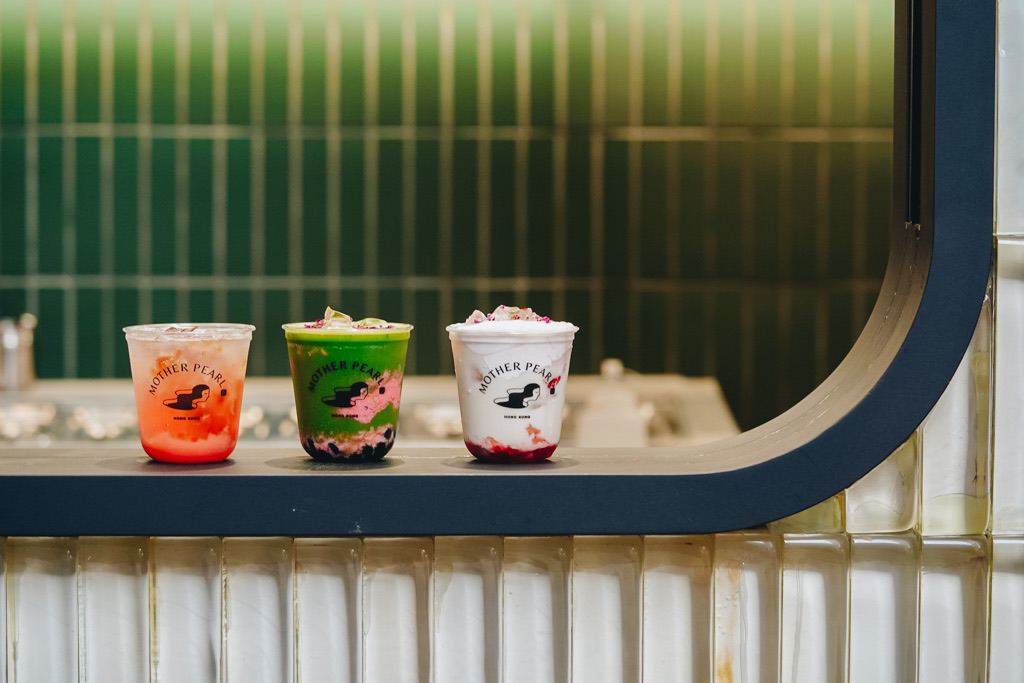
Let me just lay my case forward with some of the picture-perfect, ultra-colourful menu options. There’s the Glimpse of Sunburst, a limited-edition drink with mango, pomelo, passionfruit, coconut nectar and froth, oat-cashew milk, blue spirulina and pink salt syrup, and blue spirulina chia seed jelly. The Pot of Gold is an oat-cashew masala chai with a turmeric spice blend, ginger molasses jelly, turmeric, activated charcoal tapioca and coconut froth. And then there’s the signature Po Mylk Tea, a condensed coconut milk and Keemun rose tea base complemented by homemade oat-cashew milk, charcoal tapioca, grass jelly, chia seeds and rose petals.
Need I say more?
A focus on health and wellness
I meet Chen at Mother Pearl’s flagship in Hong Kong Central. It’s a quaint little store clad with wood all around. The exterior is dirty green, and the whole thing looks like a giant jukebox or even a pretty vintage toaster oven. Inside, there’s a section with lights that look like – are you ready? – giant tapioca pearls. And if that wasn’t enough bubble brainwashing, there stands Chen, in an all-black outfit with a striking red pearl necklace.
We take a walk in the busy street, and march uphill. Chen tells me Mother Pearl was born out of her children’s adoration for bubble tea, and her own hatred for protein shakes. “My kids love bubble tea – who doesn’t?” she posits, understandably. “Like, you have this chewy little thing, it’s kind of cute. But I know that I can’t feed them sugar all the time. It would just be irresponsible. I would just jokingly say: ‘Oh, what if Mommy can make a bubble tea brand? You can just drink it all day every day.'”
This, combined with the shit her gym trainer was giving her for her lack of tofu-eating (“You need more protein, or you’re never going to build the muscle you want”), is what sparked the idea. “What if I could make this protein, nutritious drink into something I can drink?” she recalls thinking. “Bubble tea!”
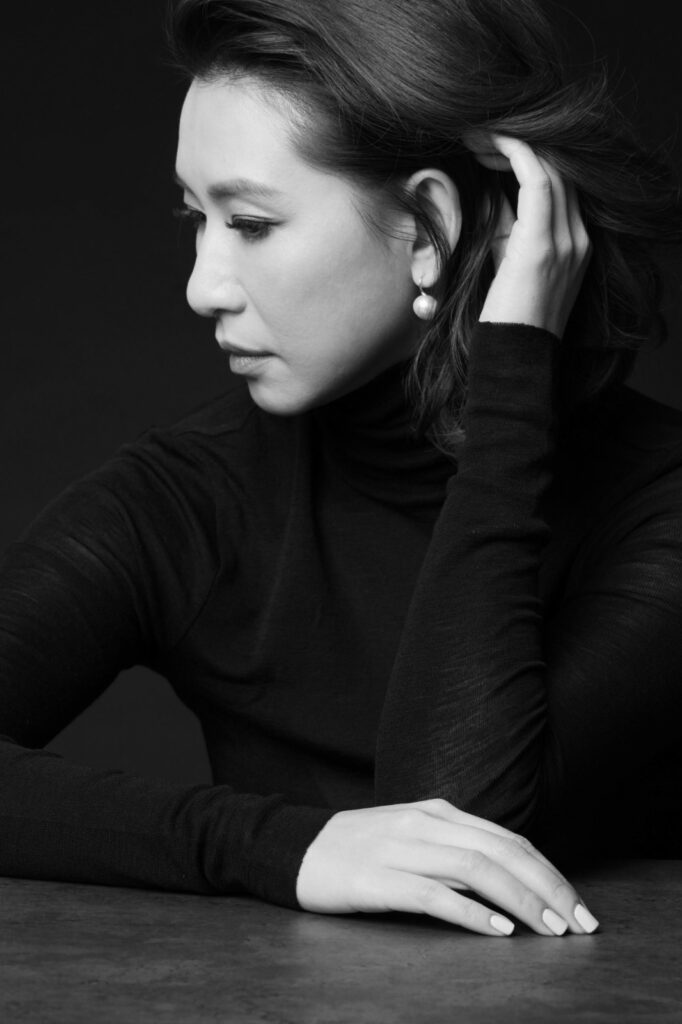
It’s why she uses better-for-you sweeteners, such as coconut nectar, blackstrap molasses and monkfruit sugar, and superfood ingredients like moringa, chia seeds, activated charcoal and blue spirulina. Mother Pearl also makes most of its ingredients, including the milks and boba, in-house (only nate de coco and some seasonal ingredients are sourced externally, but locally).
I ask her why. “Because I have to drink it! My kids have to drink it!” exclaims Chen, honing in on the healthy aspect of the bubble teas. “That was my intention – I wasn’t thinking about making this chain.” But a chain it is now, and a wildly successful one at that. The brand launched around the same time as Covid-19 became a widespread pandemic, and while the grab-and-go aspect of bubble tea made it slightly easier, the going was still tough.
Initially, Chen was helped by her sister and her sister’s husband (who is a chef). Raw materials, wages and rent made up most of the business’s costs, and it was haemorrhaging money in the first couple of years. It was only when Chen’s sister left to focus on her family that she realised she had to make it on her own. With no experience in F&B or finance, she began looking at the numbers (“I really hated numbers”), and figured out that she had to open more stores in order to break even.
Three years in, the brand just soft-launched its fifth store in Hong Kong’s Mongkok neighbourhood this week. And this Sunday, it will see a sixth store soft-open at East Point City, before a full opening for both locations on October 1. Moreover, Mother Pearl has expanded its manufacturing lines, moving to a bigger central kitchen, from a 1,500 sq ft space to a 6,000 sq ft one.
Homemade, homemade, homemade
We circle back towards the aspect of homemade ingredients, just as we see a newly married couple getting a photoshoot in the middle of the cobbled street. The brand makes its own tapioca pearls – and while it’s common for bubble tea brands to soak their boba in a brown sugar syrup, it’s obviously not how Mother Pearl rolls. “We use coconut nectar with alkaline water,” Chen tells me. Why the latter? Because – you guessed it – “I have to drink it”.
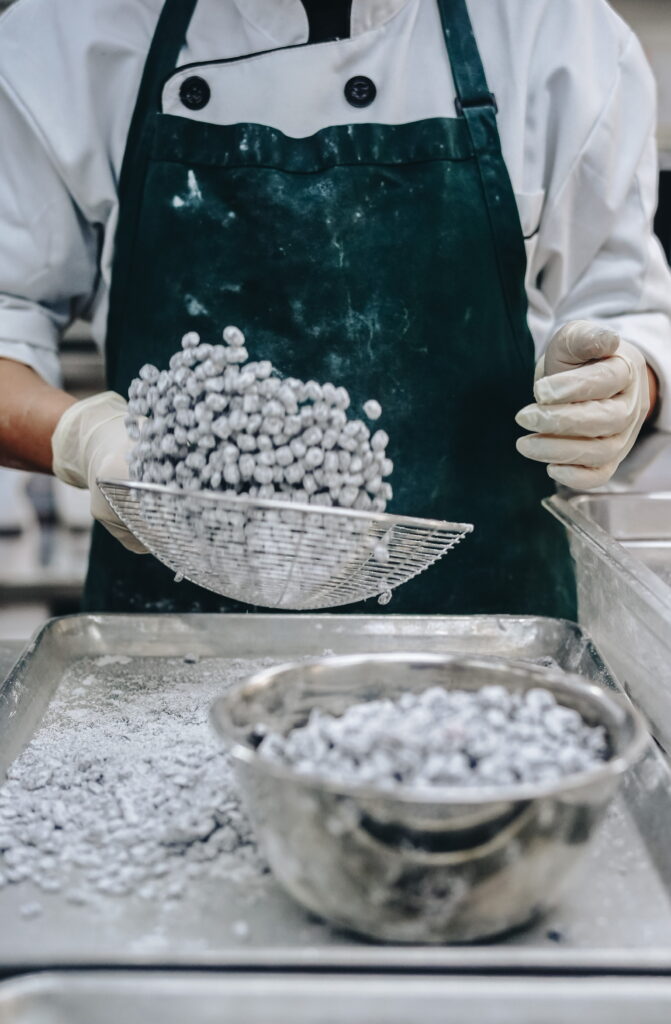
Another element developed in its central kitchen is the ‘mylk’ bases, which include almond, oat and cashew, and golden oat. But surely it’s cheaper to buy alt-milk? “Of course!” says Chen. “But I know for a fact that packaged milk is, like, 2% ingredients?” The bubble tea brand’s milks contain a much higher percentage of the base ingredient – for example, its almond milk contains 55% of the nuts, while the oat and cashew blend has 58% of the two ingredients. Pink salt, a little coconut oil and dates make up the rest of the composition.
In addition to all this, Mother Pearl has a low-waste ethos in its operations. So the leftover pulp from making these vegan milks is usually put to use in its food and bakery offerings. Right now, Chen’s team is dehydrating this pulp into flour to develop a ravioli (production name: “Pearlioili”) and plant to use it for dishes like empanadas and almond crackers in its catering menu (it has hosted events for Bloomberg and Lululemon, and is soon to do one for Mercedes-Benz), and sells this flour too.
This kind of innovation is a constant for the brand. The reason we’re in the street is because the store is having an R&D session at the back. The team is currently testing a vegan ice cream and a range of craft coffee drinks, and eventually wants to introduce SKUs on supermarket shelves too.
But to make this circular model work, something had to give. There won’t be any cashew milk available at the new Mongkok store, which will instead focus just on the almond and oat milks, because “I need enough pulp”. It’s a testament to the brand’s commitment to its low-waste principles – how many businesses out there pivot their offerings to maintain circularity?
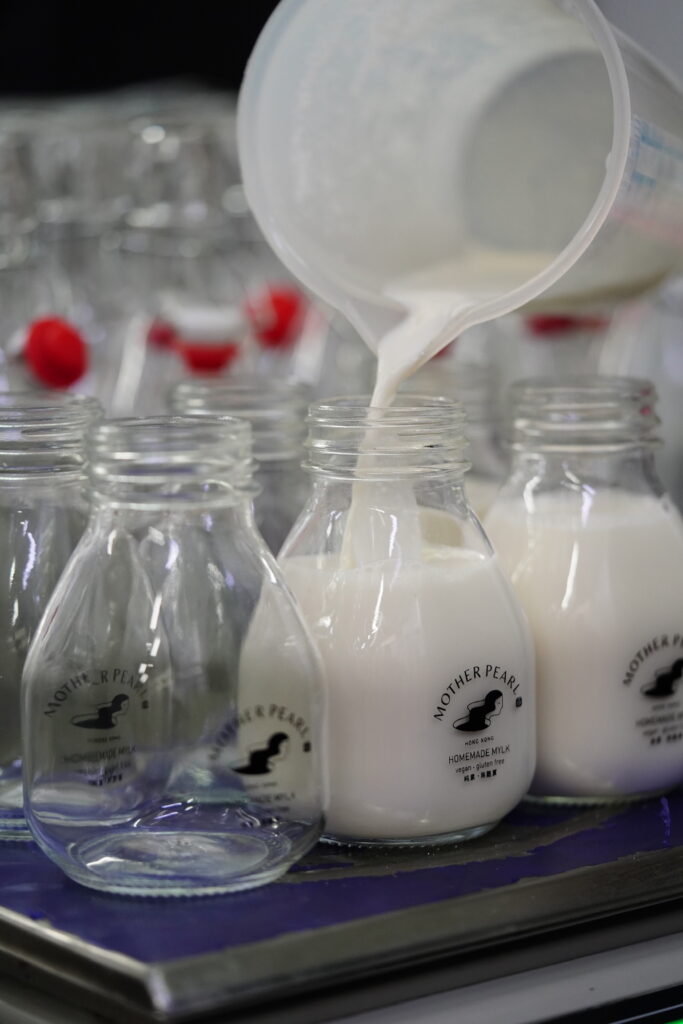
Speaking of waste, Mother Pearl does use plastic takeaway cups at the moment. Chen’s head falls back, as she looks to the sky in annoyance. “I’m so frustrated,” she tells me. Before launching, the brand bought thousands of PLA cups as they could be recycled at a nearby plant, but that facility shut down right before the first store opened. And while it does encourage refills for the milks it sells, provides a $2 discount for bringing your own cup, and recycles the cups customers drink in-store, the packaging material is something Chen wants to change, and has had regular talks with her financial team about.
Consolidation, fundraising and international expansion
Asia is, of course, the home continent for bubble tea (it originated in Taiwan in the 80s). Southeast Asians spend $3.66B on bubble tea each year. Hong Kong itself has over 100 brands and 1,000 bubble tea shops, according to one estimate. How does Mother Pearl keep up?
“We’re just very different. We use real food to make this drink, it’s not chemicals,” states Chen, before adding: “It is called ‘bubble tea’, but it’s a wellness brand.” Mother Pearl was part of her larger Po House brand – a confluence of sustainable fashion, green beauty and bubble tea.
“Nobody was buying clothes,” she says. “And also, I was actually telling people not to buy clothes.” So she decided to close the clothing brand. The beauty side of the business is fully e-commerce and outsourced to a central office in Canada (though Chen still makes the decisions).
The popularity of bubble tea has now transcended continents. It’s a global market that’s expected to surpass $4B in value by 2030. Chen tells me she’s already had requests to open Mother Pearl in places like Vancouver, Seattle, London, Shanghai, Thailand and Japan. Is she tempted to expand internationally?
You bet she is, but she remains a cautious, pragmatic operator. Chen first wants to consolidate and strengthen the brand’s foothold in its home city. She says it will need a better and bigger production line, a more diverse food and drinks menu, an increased workforce, and more investment before she looks elsewhere.
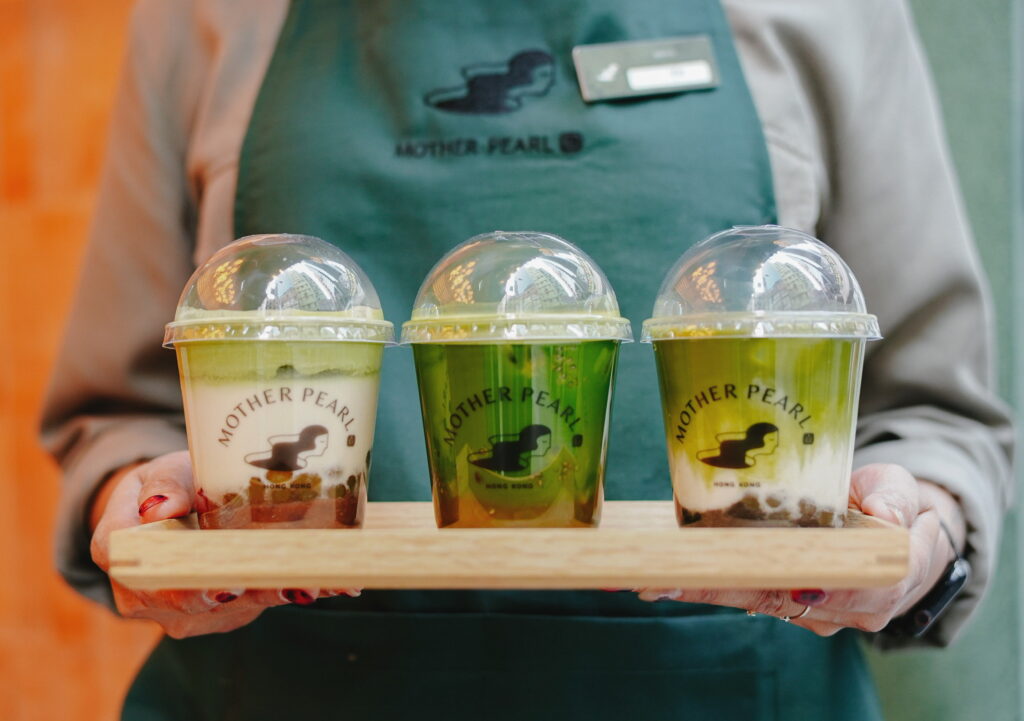
Mother Pearl, which she funded herself, has had interest from investors, but Chen doesn’t want to franchise the stores in a way that compromises her vision. “It would need to be a viable business [model] for me to make that happen. We’ll still operate the store, but they can be a silent investor.”
But do you want to know her grand plan? “Oh,” she sighs, head shaking. “It’s going to be crazy. I’ve always wanted to have Mother Pearl and my clean beauty brand to merge together and become a public company.” Chen has never felt like a businesswoman, but she says it’s time to get rid of that thinking. Mother Pearl aims to run a fundraising round in April 2025 and plans to use that investment to further its IPO goals.
“I know, it’s such an ambitious thing,” she notes. “But then, like, life is short.”

